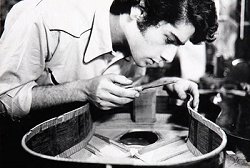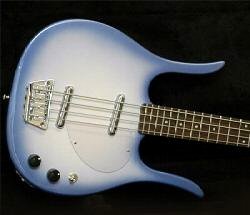
Building an acrylic line of guitars and basses was not without its challenges however, and Dan soon discovered that he
and Ampeg had different agendas. While Dan wanted to build quality instruments, Ampeg wanted it to be easily affordable,
and it had to be to market within the time frame specified within the contract. Dan understood all this, but was not
one to sacrifice quality for sales, and manufacturing acrylic instruments was, as one former Ampeg employee stated
"very time consuming". But putting their differences aside, both Dan Armstrong & Ampeg forged ahead with Dans
new visions.
The body was made of Polymethyl methacrylate (PMMA) or poly (methyl 2-methylpropenoate) which is the synthetic polymer of
methyl methacrylate. This thermoplastic and transparent plastic is sold under various tradenames such as Plexiglas, Perspex,
Plazcryl, Acrylite, Acrylplast, Altuglas, and Lucite. It is commonly called acrylic, tho some refer to it as acrylic 'glass'.
The material was developed in 1928 in various laboratories and was brought to market in 1933 by the Rohm and
Haas Company. By the late 1960's acrylic sheets were readily available, and it's rumored that Ampeg purchased acrylic sheets for the Dan
Armstrong bass and guitar bodies from Westlake Plastics.
The words Plexiglas and Plexiglass often get thrown around by many. To learn the difference a good read can be found
here.
At left, small sheets of acrylic are routed into Dan Armstrong styled acrylic instrument bodies. Today, this is done with CNC routers,
and other similar technologies. In 1969 though, this was done with saws and other labor intensive tools. While there were templates
used it was still a long and (according to former Ampeg engineer Steve Constantelos) "tedious" work. As seen at right, Rohm and Haas actually
experimented with many uses of acrylic including musical instruments. Seen better in enlarged view is a violin, clarinet, and a flute.
Dan stated that he chose acrylic "because it could be cut and sanded like wood, yet it was dense and its rigidity would allow for maximum
sustain." Ampeg would later modify Dan's words in their literature and brochures to say "the material is so
dense that it virtually eliminates all unwanted vibrations and frequencies."
While Dan had worked out the design of the guitar body, the first step was to create a prototype, and to help him in this endeavor, he turned to none other
than 20 year old Matt Umanov who was already a master luthier and had repaired many
guitars for Dan in the past. Matt Umanov recalls the experience stating "Dan and I knew one another, were good friends, and one day he just called me up
and asked for my help as he needed a prototype guitar made that had a clear acrylic body and a bolt-on maple neck, but he really didn't know how to proceed
with making one. So I told him no problem Danny, it's just something to build."

|
Seen at left, Matt Umanov working on a 1930s or 40s Martin D-28 that belonged to Steve Mandell, who gained notoriety as the guitar player in
the “Dueling Banjos" theme from the 1972 movie 'Deliverance' and was awarded a Grammy. Matt states "I’m 99% sure the pic was taken when I had my workshop
set up in Danny’s basement shop area on LaGuardia Place. I still have the chisel I’m holding in the pic and its still quite good." Courtesy of Matt Umanov.
|

|
"The shape of the body for the clear guitar and bass was derived from Dan's love of the Danelectro
Long Horn bass."says Kurt Munkcasi, who continues saying "Dan loved the feel of the body shape when it was
strapped on and he loved the look of the horns. Even more so, he loved how functional it was, for it was very easy
to get to the upper registers. When the time came to design his own instruments, he said he wanted them to have the
same feel & functionality."
Steve Kubica remembers a very early body template, stating "Dan had a plywood template of the clear guitar body at his
shop for a few weeks."
|
Steve continues, adding "The last I saw it he was working out the placement of the strap buttons for it. It
had a narrow wooden stick, or board attached to it that was supposed to represent the neck. Actually, it didn't even
look like the body style that we now know, it looked more like"...... At this point I could no longer resist, & I
jumped in and interrupted him at this point, stating ..... "More like a Danelectro long horn bass.... didn't it?"
(Steve had no idea that I had long ago learned this in my interview with Kurt Munkcasi) and he said "Yeah...... how
did you know that?" At this point I could no longer contain my laughter and as I began to chuckle, I explained my
interview with Kurt to him.
However, the Danelectro body style was only the inspiration for Dan's new guitar body, not the end product, and it
eventually gave way to the actual production body style that we all know. The following photos on this page are all
courtesy of Mr. Matt Umanov.
Matt Umanov goes on to say..."there were no blueprints or eloquent drafting plans to follow for the body shape, Dan just
took a piece of orange colored cardboard and hand drew the shape of the guitar body he wanted, and said "make it like
this". So I went and got a piece of clear acrylic and transferred the cardboard drawing onto it. Then, using a bandsaw
I cut it to shape, sanded and buffed it all out, then I used a router to make the neck, pickup & control cavities."
At upper left, an incredible find. Matt Umanov still has the actual orange piece of cardboard that Dan drew his design
on and that Matt used to transfer to the pieces of acrylic to make the prototypes. Matt goes on to add "The body
template (used for both guitar and bass) is actually more orange than in this photo, and I remember Danny giving it to
me already drawn out roughly on this piece of cardboard and I cleaned up the lines and curves, then cut it out with an
Exacto knife. You can still see some pencil lines that were altered a bit." (more noticeable in the
enlarged view).
At upper right, an equally incredible find. A design drawing of the headstock to be used on the acrylic instruments.
Matt adds "This is my own hand-drawn peghead design workup, with Armstrong/New York on it in the
style of D'Angelico peghead logo inlay." Notice the pencil lines of a straight-edge, used for the
layout of the tuners.
More incredible finds from Matt Umanov! Actual hand written spec sheets of the acrylic instruments. These were of the
guitar model. Matt goes on to explain "This was Danny's guitar spec sheet, both front and back sides." On the
front side of the page (upper left) notice the original design for the guitar headstock, which was styled after a
1924-34 Gibson L5 guitar which is further examined in the neck section of the site.
On the upper right is the backside of the guitar spec sheet (notice how the coffee stain is exactly the reverse that of the
front side). Although the backside is not as legible, according to Matt it reads as follows:
scale 241/2 -
frets length 0-24 183/8 -
24 to bridge 61/8
Matt finishes, adding "What appears to be below the above print is actually a bleed-through from the other side of
the paper due to that little bit having been written in fine-point marker. Everything else on the front and back is in
pencil."
At left, Matt describes the paper as "Danny's bass spec sheet (only one side written on) with a little drawing of
a generic bass peghead in it." Notice the unusual design that Dan had drawn for the bass headstock. It must be
remembered that these design drawings were very early on in the development of the prototypes and at some point Dan
had decided to make the bass headstock like the guitar model. Also notice the interesting drawn-in emblem on the
headstock - no doubt meant to be the Ampeg 'a' logo (more easily seen in the enlarged view). Like the guitar pages
above these pages have yellowed with age and feature a few coffee stains on it.
At the upper right Matt states "this is the original cardboard template for the pickguard (possibly drawn by Danny) and
cut out by me." The pickguard shape would go through many changes until it would take the shape and form that we all now
recognize.
continue
menu
Names and images are TMand © Dan Armstrong / Ampeg. All rights reserved.
All other names and images are TMand © of their respective owners. All rights reserved.
|
| |

